La guida completa di guida e noleggio Irlanda
Speed Limit and Traffic Signs
Driving in Ireland is on the left-hand side. Before you drive on Irish roads, we recommend you to choose a compact car since roads in Ireland - especially those in countryside - tend to be narrow. Do not forget that honking around residential areas from 23:30 to 7:30 is prohibited.
 Speed Limit
Speed LimitSome general speed limits should be kept in mind while driving. There are speed limits of 31 mph (50 km/h) in built-up areas, 50 mph (80 km/h) for non-national roads, 61 mph (100 km/h) for national roads and 75 mph (120 km/h) in motorways unless signs say otherwise.
 Traffic Signs
Traffic SignsTraffic signs in Ireland can be mainly classified into 3 types: regulatory signs, warning signs and information signs.
Irish regulatory signs are mostly circular and feature red, with some exceptions.
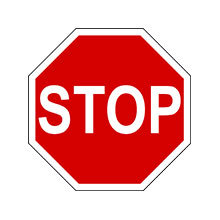 Stop
Stop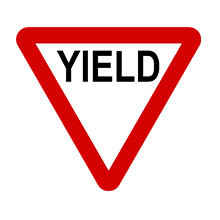 Yield
Yield Yield (In Irish)
Yield (In Irish)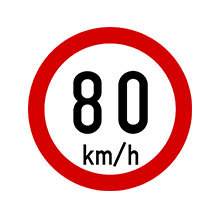 Max Speed Limit (80 km/h)
Max Speed Limit (80 km/h)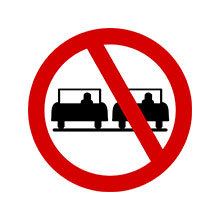 No Overtaking
No Overtaking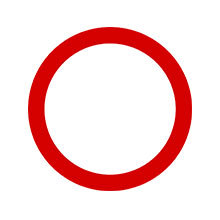 Pedestrianized Street
Pedestrianized StreetWarning signs are diamond shaped with a yellow background.
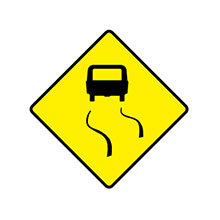 Slippery Road Ahead
Slippery Road Ahead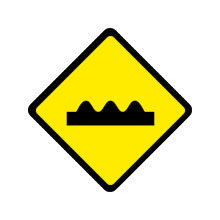 Series of Bumps or Hollows Ahead
Series of Bumps or Hollows Ahead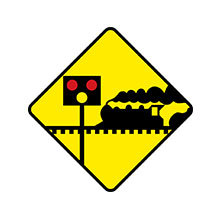 Level Crossing with Lights and Barriers
Level Crossing with Lights and Barriers Pedestrian Crossing Ahead
Pedestrian Crossing Ahead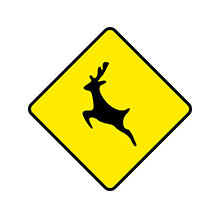 Deer or Wild Animals
Deer or Wild AnimalsIrish regulatory signs are mostly rectangular with different background colours.
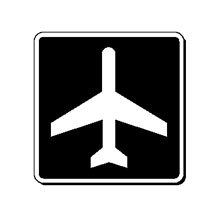 Airport Sign
Airport Sign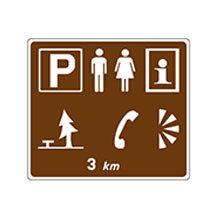 Advance Sign for Facilities in Lay-bay
Advance Sign for Facilities in Lay-bayTo read more about Irish traffic signs, you can refer to Ireland Traffic Signs Manual 2010.
Seatbelt and Child Safety
 Seatbelt Laws
Seatbelt LawsAll passengers are required to have their seatbelt fastened at all times when the vehicle is moving. Drivers are obliged to make sure passengers under 17 are suitably restrained. Failing to do so can result in a fine of €60 which must be paid within 28 days.
 Booster Seat Laws
Booster Seat LawsAll children under 17 must be in an appropriate restraint system when they are in a vehicle. Kids under 150cm (4ft and11in) in height or 36kg (79lbs) in weight must sit in correct child restraints that are appropriate to the weight of the child and must be in accordance with EU or UN standards. Rear facing child restraints must not be used in seats protected by an active frontal air-bag.
Parking, Fuel and Toll
 Parking
Parking· Forbidden Parking
You must not park on the following spots:
- Opposite to another vehicle on a narrow road
- At the entrance or exit of a fire station, police station, ambulance station or hospital
- Where you would block other road users' views of a traffic signal or the road ahead
- 15 metres before or 5 metres after pedestrian crossings or traffic lights
- Where parking is forbidden by traffic signs or road markings, as detailed below
- When there is a single yellow line as a road mark with an upright information plate nearby, you must not park during the times shown
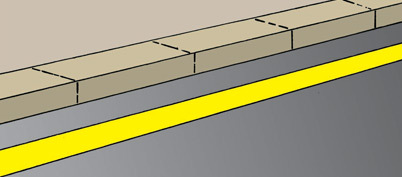 (Image from bcmtouring.com)
(Image from bcmtouring.com)- When there are double yellow lines, you are not allowed to park at any time
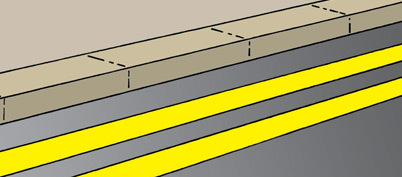 (Image from bcmtouring.com)
(Image from bcmtouring.com)- Parking spots with a disabled person symbol are only available for people suffering from a disability
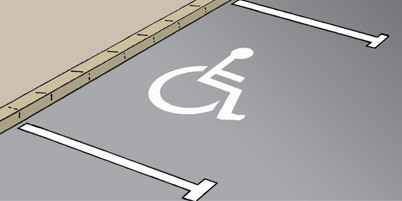 (Image from bcmtouring.com)
(Image from bcmtouring.com)· Parking Sign
Permitted and prohibited parking signs in Ireland may specify multiple times, places, durations, restrictions and vehicle categories in a condensed form on a single sign.
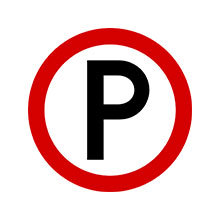 Parking Permitted
Parking Permitted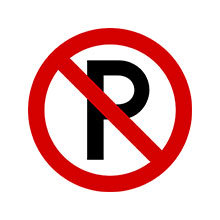 Parking Prohibited
Parking ProhibitedYou may also find this sign with two-way diagonals indicating a specific area must be kept clear during the specified times of the day.
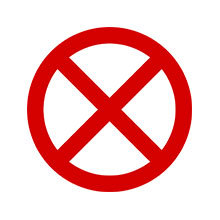 Clearway
Clearway· Paid Parking
Disc parking and Pay-and-Display parking system are both valid in Ireland. You are most likely to find a solar powered meter for Pay-and-Display, which prices usually range from 80 cent to €2.9 per hour.
 Fuel Prices
Fuel PricesThe average value for Ireland gasoline price during November to December, 2017 is 1.4 Euro, while diesel is 1 cent lower.
 Toll
TollBoth Irish residents and foreign tourists using a toll road should pay for the fee. There are eleven toll roads in Ireland.
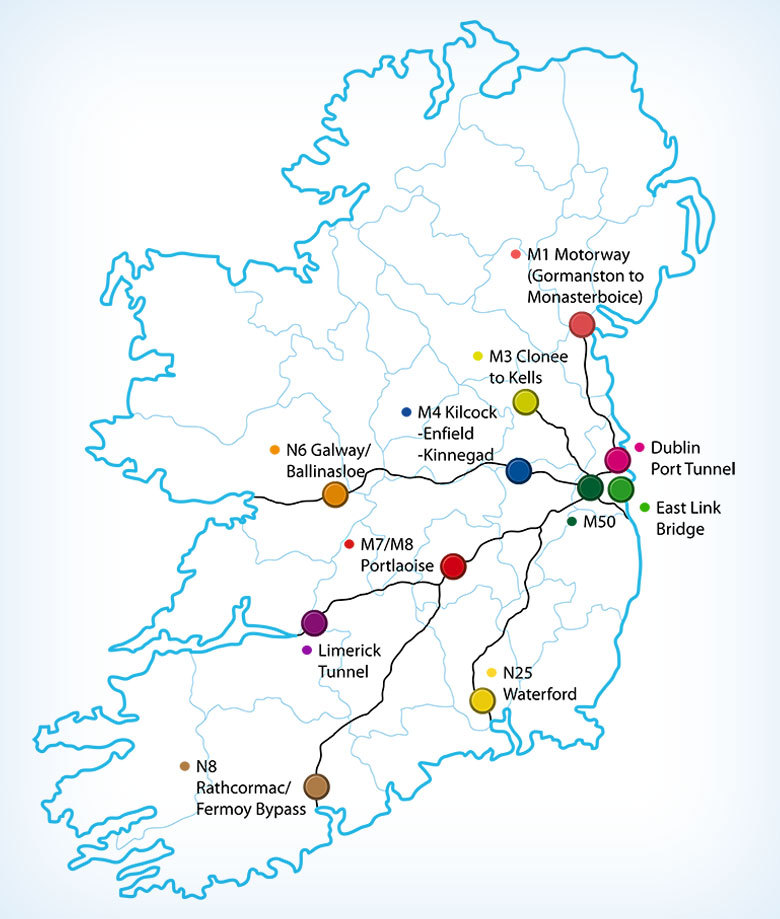 (Image from eflow.ie)
(Image from eflow.ie)You will need to stop at the toll plaza to pay the tolls either by cash or by card, and 10 of the toll roads in Ireland are equipped with barrier toll plazas except for the M50. To use the M50, you need to pay before 8pm the following day. Failure to do so will result in a fine of €3.00.
If you plan to rent a car and use the toll roads in Ireland, it is advisable for you to rent an electronic tag from the car hire company, enabling an automatic payment of the toll fee directly from your credit card. Please note that electronic tags are subject to availability at the rental desk. If you have any question related to your toll fee billing, feel free to contact QEEQ' 24/7 customer service team for assistance.
Traffic Violation
 DUI Laws
DUI LawsIn Ireland, drink driving is a serious offence. The legal limit varies and depends on drivers’ qualifications. Full licenced drivers are not allowed to consume more than the legal alcohol limit which is 50 micrograms per millilitres of blood while professional and learner drivers are limited at 20mg/100ml. Being deemed as drunk driving will result in a two-year ban and a €1,500 fine.
 Traffic Fines
Traffic FinesIf you are caught speeding on the road, you need to pay €80 as a fine and give out 3 penalty points in 28 days. If you miss the deadline, you need to pay €120 in another 28 days. If you still have not proceeded to the payment after 56 days, a court case will be filled against you.
Parking offence will result in a fine from €40 to €80 depending on the situation.
Car hire companies will pass on the driver’s information to the authorities in case of traffic infringement, while the post or email notification enlisting breach details will only be issued by the traffic authority.
Note that the fine usually comes with a service/administration fee as well. It is advisable for you to contact QEEQ' 24/7 customer service team if you have any question on this matter.
Driving Licence and Age Requirements
To drive in Ireland, the driver must present a valid national driving licence that has been held for at least 2 years. The minimum age to drive in Ireland is 21 years old (age may vary by car category).
To hire a car in Ireland, you must be at least 21 years old (age may vary by car category). Each car hire company has its own age requirements and a deviation from the minimum age is possible depending on the vehicle.
Leggi maggiori dettagli
Le migliori offerte di noleggio auto in Irlanda
Domande frequenti
- Q1. Che cos'è la franchigia assicurazione?L'eccesso è l'importo che sarà responsabile solo per in caso di danni (sotto la rinuncia danni collisione) o furto (sotto protezione furto) del veicolo.
Le informazioni sull'eccesso saranno chiaramente indicate nell'inclusione dei prezzi quando prenoti un'auto su QEEQ. - Q2. Come posso aggiungere un driver aggiuntivo?Si consiglia di effettuare una richiesta al momento del vostro arrivo al banco noleggio. Il costo aggiuntivo per giorno sarà addebitato a meno che non sia previsto il "1 driver aggiuntivo incluso" sul noleggio.
si prega di notare che la stessa licenza e requisito di età RGPD al conducente supplementare. Il conducente aggiuntivo dovrebbe presentare il documento di licenza richiesto insieme al conducente principale al momento del ritiro. - Q3. Cosa succede se voglio ritirare o lasciare la mia auto a noleggio fuori dall'orario d'ufficio?QEEQ vi mostrerà le offerte di auto disponibili al momento scelto sui risultati di ricerca.
tuttavia, il ritiro o la riconsegna fuori degli orari di apertura generali può essere soggetto a un costo aggiuntivo, a meno che non sia disponibile il servizio di trasferimento self-service o drop-off.
Dopo aver effettuato la prenotazione di un'auto su QEEQ, vi informeremo della politica specifica della società di autonoleggio via e-mail. - Q4. Posso prendere l'auto noleggiata in un altro paese o attraversare il confine?Se si desidera ritirare la vostra auto in un paese e rilasciarlo in un altro, i risultati della ricerca vi mostrerà auto che si può fare con.
se avete intenzione di attraversare qualsiasi confine durante il vostro viaggio, tenete a mente:
1. potrebbe essere necessario pagare di più.
ci sono spesso costi aggiuntivi, tasse o copertura aggiuntiva che pagherai al banco di noleggio auto.
2.It potrebbe non essere consentito.
a seconda di dove stai assumendo, potresti non essere in grado di portare la tua auto in un altro paese.
Si prega di inviarci un'e-mail se si desidera prendere la vostra auto a noleggio in un paese diverso durante il viaggio, e vi parleremo attraverso le opzioni. - Q5. Posso ritirare la mia auto in una posizione e restituirla in un luogo diverso?sì. È possibile ritirare il veicolo in un unico posto e rilasciarlo in un altro. Verrà addebitata una "tassa unidirezionale". Se è incluso nel prezzo di affitto o quale costo aggiuntivo può sorgere sarà chiaramente indicato al momento della prenotazione su QEEQ.
si prega di informare la società di autonoleggio del vostro luogo di riconsegna quando si prende il veicolo o contattarli direttamente durante il viaggio. Troverete un numero di telefono sul contratto di noleggio che avete firmato al momento del ritiro.
Qualche domanda? Basta visitare il nostro help pagina .
Esplora altre destinazioni a Irlanda
Our Advantages
Iscriviti per offerte e offerte esclusive
Si prega di inserire un indirizzo email valido


 Stop
Stop Yield
Yield Yield (In Irish)
Yield (In Irish) Max Speed Limit (80 km/h)
Max Speed Limit (80 km/h) No Overtaking
No Overtaking Pedestrianized
Pedestrianized Slippery Road Ahead
Slippery Road Ahead Series of Bumps or Hollows Ahead
Series of Bumps or Hollows Ahead Level Crossing with Lights and Barriers
Level Crossing with Lights and Barriers Pedestrian Crossing Ahead
Pedestrian Crossing Ahead Deer or Wild Animals
Deer or Wild Animals Airport Sign
Airport Sign Advance Sign for Facilities in Lay-bay
Advance Sign for Facilities in Lay-bay


 (Image from bcmtouring.com)
(Image from bcmtouring.com) (Image from bcmtouring.com)
(Image from bcmtouring.com) (Image from bcmtouring.com)
(Image from bcmtouring.com) Parking Permitted
Parking Permitted Parking Prohibited
Parking Prohibited Clearway
Clearway

 (Image from eflow.ie)
(Image from eflow.ie)

